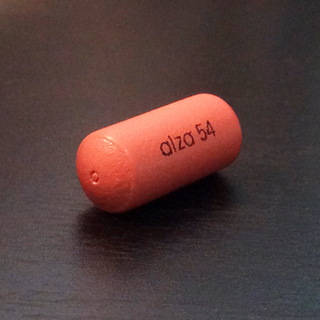Related Research Articles

Theophylline, also known as 1,3-dimethylxanthine, is a drug that inhibits phosphodiesterase and blocks adenosine receptors. It is used to treat chronic obstructive pulmonary disease (COPD) and asthma. Its pharmacology is similar to other methylxanthine drugs. Trace amounts of theophylline are naturally present in tea, coffee, chocolate, yerba maté, guarana, and kola nut.

Methylphenidate, sold under the brand names Ritalin and Concerta among others, is a central nervous system (CNS) stimulant used medically to treat attention deficit hyperactivity disorder (ADHD) and, to a lesser extent, narcolepsy. It is a primary medication for ADHD ; it may be taken by mouth or applied to the skin, and different formulations have varying durations of effect, commonly ranging from 2–4 hours.

Lorazepam, sold under the brand name Ativan among others, is a benzodiazepine medication. It is used to treat anxiety, trouble sleeping, severe agitation, active seizures including status epilepticus, alcohol withdrawal, and chemotherapy-induced nausea and vomiting. It is also used during surgery to interfere with memory formation and to sedate those who are being mechanically ventilated. It is also used, along with other treatments, for acute coronary syndrome due to cocaine use. It can be given by mouth or as an injection into a muscle or vein. When given by injection, onset of effects is between one and thirty minutes and effects last for up to a day.
In pharmacology, bioavailability is a subcategory of absorption and is the fraction (%) of an administered drug that reaches the systemic circulation.

Rabeprazole, sold under the brand name Aciphex, among others, is a medication that decreases stomach acid. It is used to treat peptic ulcer disease, gastroesophageal reflux disease, and excess stomach acid production such as in Zollinger–Ellison syndrome. It may also be used in combination with other medications to treat Helicobacter pylori. Effectiveness is similar to other proton pump inhibitors (PPIs). It is taken by mouth.

Dexmethylphenidate, sold under the brand name Focalin among others, is a strong central nervous system (CNS) stimulant used to treat attention deficit hyperactivity disorder (ADHD) in those over the age of five years. It is taken by mouth. The immediate release formulation lasts up to five hours while the extended release formulation lasts up to twelve hours. It is the more active enantiomer of methylphenidate.
An excipient is a substance formulated alongside the active ingredient of a medication. Excipients serve various purposes, including long-term stabilization, bulking up solid formulations containing potent active ingredients in small amounts, or enhancing the therapeutic properties of the active ingredient in the final dosage form. They can facilitate drug absorption, reduce viscosity, or enhance solubility. Excipients can also aid in the manufacturing process by improving the handling of active substances, facilitating powder flowability, or preventing denaturation and aggregation during the expected shelf life. The selection of excipients depends on factors such as the route of administration, dosage form, and active ingredient.

Bioequivalence is a term in pharmacokinetics used to assess the expected in vivo biological equivalence of two proprietary preparations of a drug. If two products are said to be bioequivalent it means that they would be expected to be, for all intents and purposes, the same.

Docetaxel, sold under the brand name Taxotere among others, is a chemotherapy medication used to treat a number of types of cancer. This includes breast cancer, head and neck cancer, stomach cancer, prostate cancer and non-small-cell lung cancer. It may be used by itself or along with other chemotherapy medication. It is given by slow injection into a vein.
An enteric coating is a polymer barrier applied to oral medication that prevents its dissolution or disintegration in the gastric environment. This helps by either protecting drugs from the acidity of the stomach, the stomach from the detrimental effects of the drug, or to release the drug after the stomach. Some drugs are unstable at the pH of gastric acid and need to be protected from degradation. Enteric coating is also an effective method to obtain drug targeting. Other drugs such as some anthelmintics may need to reach a high concentration in a specific part of the intestine. Enteric coating may also be used during studies as a research tool to determine drug absorption. Enteric-coated medications pertain to the "delayed action" dosage form category. Tablets, mini-tablets, pellets and granules are the most common enteric-coated dosage forms.

Clorazepate, sold under the brand name Tranxene among others, is a benzodiazepine medication. It possesses anxiolytic, anticonvulsant, sedative, hypnotic, and skeletal muscle relaxant properties. Clorazepate is an unusually long-lasting benzodiazepine and serves as a prodrug for the equally long-lasting desmethyldiazepam, which is rapidly produced as an active metabolite. Desmethyldiazepam is responsible for most of the therapeutic effects of clorazepate.

Acamprosate, sold under the brand name Campral, is a medication used along with counseling to treat alcohol use disorder.

Tofisopam is an anxiolytic that is marketed in several European countries. Chemically, it is a 2,3-benzodiazepine. Unlike other anxiolytic benzodiazepines however, tofisopam does not have anticonvulsant, sedative, skeletal muscle relaxant, motor skill-impairing or amnestic properties. While it may not be an anticonvulsant in and of itself, it has been shown to enhance the anticonvulsant action of classical 1,4-benzodiazepines and muscimol, but not sodium valproate, carbamazepine, phenobarbital, or phenytoin. Tofisopam is indicated for the treatment of anxiety and alcohol withdrawal, and is prescribed in a dosage of 50–300 mg per day divided into three doses. Peak plasma levels are attained two hours after an oral dose. Tofisopam is not reported as causing dependence to the same extent as other benzodiazepines, but is still recommended to be prescribed for a maximum of 12 weeks.

Drug delivery refers to approaches, formulations, manufacturing techniques, storage systems, and technologies involved in transporting a pharmaceutical compound to its target site to achieve a desired therapeutic effect. Principles related to drug preparation, route of administration, site-specific targeting, metabolism, and toxicity are used to optimize efficacy and safety, and to improve patient convenience and compliance. Drug delivery is aimed at altering a drug's pharmacokinetics and specificity by formulating it with different excipients, drug carriers, and medical devices. There is additional emphasis on increasing the bioavailability and duration of action of a drug to improve therapeutic outcomes. Some research has also been focused on improving safety for the person administering the medication. For example, several types of microneedle patches have been developed for administering vaccines and other medications to reduce the risk of needlestick injury.

The osmotic-controlled release oral delivery system (OROS) is an advanced controlled release oral drug delivery system in the form of a rigid tablet with a semi-permeable outer membrane and one or more small laser drilled holes in it. As the tablet passes through the body, water is absorbed through the semipermeable membrane via osmosis, and the resulting osmotic pressure is used to push the active drug through the laser drilled opening(s) in the tablet and into the gastrointestinal tract. OROS is a trademarked name owned by ALZA Corporation, which pioneered the use of osmotic pumps for oral drug delivery.
A combination drug or a fixed-dose combination (FDC) is a medicine that includes two or more active ingredients combined in a single dosage form. Terms like "combination drug" or "combination drug product" can be common shorthand for an FDC product, although the latter is more precise if in fact referring to a mass-produced product having a predetermined combination of drugs and respective dosages. And it should also be distinguished from the term "combination product" in medical contexts, which without further specification can refer to products that combine different types of medical products—such as device/drug combinations as opposed to drug/drug combinations. When a combination drug product is a "pill", then it may also be a kind of "polypill" or combopill.
Modified-release dosage is a mechanism that delivers a drug with a delay after its administration or for a prolonged period of time or to a specific target in the body.

Bevirimat is an anti-HIV drug derived from a betulinic acid-like compound, first isolated from Syzygium claviflorum, a Chinese herb. It is believed to inhibit HIV by a novel mechanism, so-called maturation inhibition. It is not currently U.S. Food and Drug Administration (FDA) approved. It was originally developed by the pharmaceutical company Panacos and reached Phase IIb clinical trials. Myriad Genetics announced on January 21, 2009 the acquisition of all rights to bevirimat for $7M USD. On June 8, 2010 Myriad Genetics announced that it was halting the development of maturation inhibitors, including bevirimat, to focus more on their oncology portfolio.

Clinafloxacin is an investigational fluoroquinolone antibiotic. Despite its promising antibiotic activity, the clinical development of clinafloxacin has been hampered by its risk for inducing serious side effects.

Alcohol, sometimes referred to by the chemical name ethanol, is a depressant drug that is the active ingredient in fermented drinks such as beer, wine, and distilled spirits. It is one of the oldest and most commonly consumed recreational drugs, causing the characteristic effects of alcohol intoxication ("drunkenness"). Among other effects, alcohol produces happiness and euphoria, decreased anxiety, increased sociability, sedation, impairment of cognitive, memory, motor, and sensory function, and generalized depression of central nervous system (CNS) function.
References
- ↑ Hendeles L, Weinberger M, Milavetz G, Hill III M, Vaughan L (1985). "Food-induced "dose-dumping" from a once-a-day theophylline product as a cause of theophylline toxicity". Chest. 87 (6): 758–765. doi:10.1378/chest.87.6.758. PMID 3996063. A landmark 1985 study on dose dumping observed when theophylline was taken with fatty meals.
- ↑ Palladone Pain Drug Pulled Off the Market as reported by WebMD in July 2005.
- ↑ D’Souza, Susan; Mayock, Stephen; Salt, Alger (2017-06-07). "A review of in vivo and in vitro aspects of alcohol-induced dose dumping". AAPS Open. 3 (1). doi: 10.1186/s41120-017-0014-9 . ISSN 2364-9534.
- ↑ Johnson, Franklin K.; Ciric, Sabrina; Boudriau, Sophie; Kisicki, James; Stauffer, Joseph (May 2012). "Effects of Alcohol on the Pharmacokinetics of Morphine Sulfate and Naltrexone Hydrochloride Extended Release Capsules". The Journal of Clinical Pharmacology. 52 (5): 747–756. doi:10.1177/0091270011403740. ISSN 0091-2700. PMID 21593282. S2CID 5978463.
- ↑ Franke, A.; Teyssen, S.; Harder, H.; Singer, M. V. (January 2004). "Effect of ethanol and some alcoholic beverages on gastric emptying in humans". Scandinavian Journal of Gastroenterology. 39 (7): 638–644. doi:10.1080/00365520410005009. ISSN 0036-5521. PMID 15370684. S2CID 21535006.
- ↑ Fagerberg, Jonas H.; Al-Tikriti, Yassir; Ragnarsson, Gert; Bergström, Christel A.S. (2012-06-20). "Ethanol Effects on Apparent Solubility of Poorly Soluble Drugs in Simulated Intestinal Fluid". Molecular Pharmaceutics. 9 (7): 1942–1952. doi:10.1021/mp2006467. ISSN 1543-8384. PMID 22651218.
- ↑ Jedinger, N.; Khinast, J.; Roblegg, E. (July 2014). "The design of controlled-release formulations resistant to alcohol-induced dose dumping – A review". European Journal of Pharmaceutics and Biopharmaceutics. 87 (2): 217–226. doi:10.1016/j.ejpb.2014.02.008. PMID 24613542.
- ↑ Missaghi, Shahrzad; Fegely, Kurt A.; Rajabi-Siahboomi, Ali R. (2009-01-16). "Investigation of the Effects of Hydroalcoholic Solutions on Textural and Rheological Properties of Various Controlled Release Grades of Hypromellose". AAPS PharmSciTech. 10 (1): 77–80. doi:10.1208/s12249-008-9181-2. ISSN 1530-9932. PMC 2663671 . PMID 19148758.
- ↑ Midha, K. K.; McKay, G.; Rawson, M. J.; Korchinski, E. D.; Hubbard, J. W. (2001). "Effects of food on the pharmacokinetics of methylphenidate". Pharmaceutical Research. 18 (8): 1185–1189. doi:10.1023/A:1010987212724. PMID 11587491. S2CID 25073909.
- ↑ Koziolek, Mirko; Kostewicz, Edmund; Vertzoni, Maria (2018-08-28). "Physiological Considerations and In Vitro Strategies for Evaluating the Influence of Food on Drug Release from Extended-Release Formulations". AAPS PharmSciTech. 19 (7): 2885–2897. doi:10.1208/s12249-018-1159-0. ISSN 1530-9932. PMID 30155808. S2CID 52112894.
- ↑ Klein, Sandra (2009). "Predicting Food Effects on Drug Release from Extended-Release Oral Dosage Forms Containing a Narrow Therapeutic Index Drug". Dissolution Technologies. 16 (3): 28–40. doi:10.14227/dt160309p28. ISSN 1521-298X.